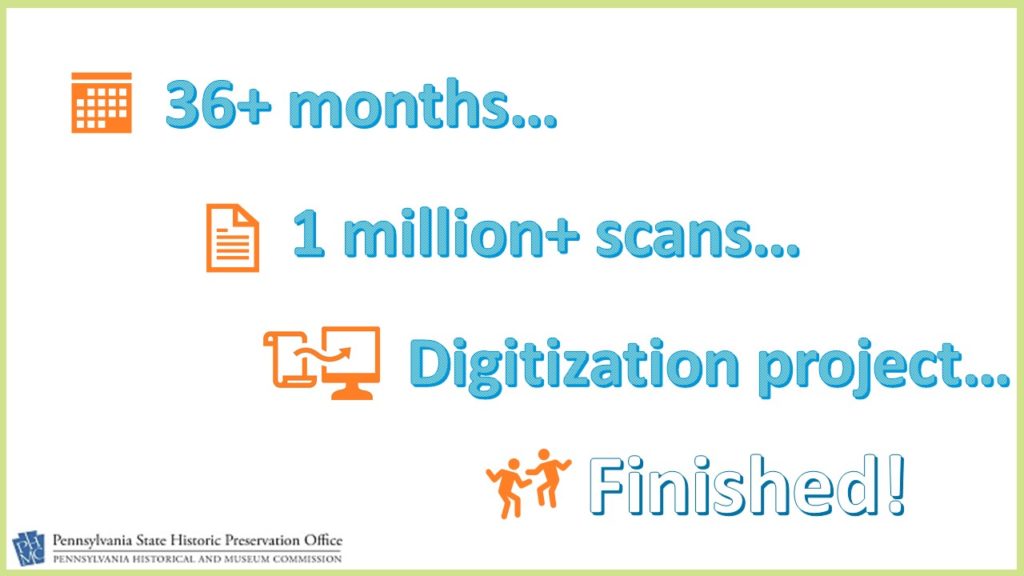There are always lots of “Things You Need to Know” in today’s world, and this week’s post features a few from our Environmental Review staff, Barbara Frederick and Doug McLearen.
Online Data Entry for Above Ground Resources
We’ve been talking about PA-SHARE for quite a while now, and we here at the PA SHPO have been changing how we operate to “model the work” to be ready when PA-SHARE is launched. How newly identified resources are submitted for review is one of those things we’ve been changing.
As we announced in early July, submissions including 10 or more newly identified resources are required to be electronically entered into CRGIS. Data entry has been well received! Thank you!
We would also like to encourage those submitters sending in projects with fewer than 10 newly identified resources to use online data entry as well.
As outlined in the updated Interim Guidelines for Above Ground Environmental Review, the process is generally the same and only varies slightly depending on the number of resources being submitted. There is some greater flexibility in the submission process:
- Submitters of less than 10 newly identified resources are to notify the appropriate above ground environmental reviewer when resources are ready for review and comment via email rather than by mail.
- Also, a table of the results of the identification effort is not required when there are fewer than 10 newly identified resources; providing the project’s Environmental Review (ER) number and the names and key numbers of resources whose data entry has been accepted by CRGIS staff as part of request to review and comment is sufficient.
Archaeology for new cell towers

Example of a cell phone tower.
It is the PA SHPO’s position that the majority of proposed new cell tower sites in Pennsylvania are commonly located in areas where significant archaeological resources are not likely to be present. Exceptions to this pattern are:
- when the Area of Potential Effect (APE) for direct effects is located on or adjacent to a previously recorded archaeological site, either pre-contact or historic; or
The APE is in a similar topographic setting as that of a previously recorded pre-contact archaeological site or otherwise associated with topographic and environmental factors that typically favor the locations of pre-contact sites; or
- when the APE has a high probability of containing historic archaeological resources based on a historical association such as buildings shown a historic map, presence of historic buildings on-site, or location in a historic district.
The FCC Nationwide Programmatic Agreement (NPA) requires that their applicants’ submission packets provide a justification for a finding that no archeological survey is necessary. If results of a thorough desktop review are provided to our office, they must contain clear, descriptive information as to why it is unlikely that archaeological resources are present. If a field visit/ survey is also undertaken—which is usually the case–the packet should then present the results.
When no archaeological resources are found in a survey, and/or the entire APE for direct effects is found to be disturbed:
- PA SHPO considers these surveys to constitute field checks rather than conventional Phase I archeological surveys. In these instances, the production of a full archaeology report will not be required. For convenience, however, the applicant should use the PA SHPO’s Negative Survey Form or, if more appropriate, the PA SHPO’s Record of Disturbance.
If a field survey does identify an archeological site within the APE for direct effects:
- PA SHPO expects the applicant’s consultant to prepare a full Phase I archeological report in complete accordance with the instructions in Guidelines for Archaeological Investigations in Pennsylvania (PA SHPO 2016). The PA SHPO will then review and comment on the finding and continue to consult with the applicant on National Register eligibility and effects.
The PA SHPO forms and documents named above can be found on the PHMC web site at: https://www.phmc.pa.gov/Preservation/About/Pages/Forms-Guidance.aspx.
We know it can be hard to keep track of all these changes, so please give us a call or send us an email with any questions!
Doug McLearen, Division Chief, can help with archaeology-related questions: dmclearen@pa.gov.
Barbara Frederick, Supervisor, can help with above-ground resources questions: bafrederic@pa.gov.








Recent Comments